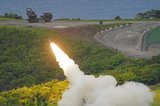Northrop Grumman, Bell Helicopter to develop, demonstrate new Medium-Range Vertical Unmanned System
US war fighters will be able to keep tabs on their enemies for longer periods of time, communicate more easily with their commanders, and deliver more cargo to more remote locations using the new Fire-X medium-range vertical unmanned aerial system (VUAS) unveiled today by Northrop Grumman Corporation and Bell Helicopter, a Textron Company.
The two companies have joined forces to develop and demonstrate the new rugged, high-capacity unmanned aerial system based on the four-blade, single-engine Bell 407 helicopter. First flight of Fire-X is expected by the end of 2010. The new system also represents Northrop Grumman's entry in an anticipated US Navy competition in 2011 to demonstrate a new medium-range UAS.
"The Fire-X system integrates Northrop Grumman's proven unmanned systems know-how with a proven, FAA-certified helicopter airframe that's been in service since 1996," said Gene Fraser, sector vice president and general manager for the Advanced Programs and Technology division of Northrop Grumman's Aerospace Systems sector. "The result will be an affordable, fast-fielding system that delivers the maturity of the unmanned systems architecture developed by the US Navy's MQ-8B Fire Scout program, while giving military services the extra UAS cargo, payload and endurance they seek."
Reporters got their first look at the new VUAS concept today in Northrop Grumman's booth at the Navy League Sea-Air-Space Exposition in National Harbor, Md.
"Bell Helicopter brings to the Fire-X development more than 50 years of experience producing and supporting US military helicopters across the full rotary-wing aviation mission spectrum, including armed reconnaissance, attack, utility, and MedEvac," said Jeff Lowinger, executive vice president of engineering for Bell Helicopter. "We're also backing this new offering with Bell's unmatched global logistics support, training, and industry-leading customer service."
Fire-X will incorporate Fire Scout's modular, field-proven architecture that accommodates a variety of intelligence, surveillance and reconnaissance (ISR) and communications payloads. It also provides complementary capabilities for missions that demand larger payloads (up to 3000 pounds), longer endurance (more than 14 hours) and robust cargo hauling (up to 2646 pounds external).
Fire-X is being designed to operate with nearly any type of current or future military standards-based control segment. It will communicate as easily with shipboard controllers using the Navy's Tactical Control Station (TCS) as field commanders using the US Army's field-proven One System® ground control station.
Fire-X is the latest in a long line of tactical UASs from Northrop Grumman, a leader in developing, integrating and testing unmanned systems for more than 60 years. In addition to using Fire Scout's unmanned systems architecture, it will draw on the company's systems integration and testing expertise acquired through developing targets for the Navy, the Army's MQ-5A Hunter fixed wing UAS, and the company's new line of scalable BatTM unmanned aircraft systems.
Fire-X also takes full advantage of Northrop Grumman's proven ability to "unman" or optionally man a manned helicopter - i.e. replace the in-vehicle pilot with the appropriate avionics, software and ground control station to accurately and reliably duplicate the behavior and performance of the air vehicle.
Source: Northrop Grumman
More from Uncrewed Vehicles
-
![What's next for the Pentagon after the Replicator programme?]()
What's next for the Pentagon after the Replicator programme?
Although the Replicator initiative has made several accomplishments, there are still multiple gaps to plug across the US Department of Defense (DoD) and its services.
-
![Cummings Aerospace showcases Hellhound loitering munition designed for US Army’s LASSO programme (video)]()
Cummings Aerospace showcases Hellhound loitering munition designed for US Army’s LASSO programme (video)
Cummings Aerospace presented its turbojet-powered Hellhound loitering munition at SOF Week 2025, offering a man-portable solution aligned with the US Army’s LASSO requirements.
-
![SOF Week 2025: PDW unveils attritable FPV drone for SOF operations at scale]()
SOF Week 2025: PDW unveils attritable FPV drone for SOF operations at scale
PDW has revealed its Attritable Multirotor First Person View drone at SOF Week 2025, offering special operations forces a low-cost, rapidly deployable platform for strike and ISR missions, inspired by battlefield lessons from Ukraine.
-
![SOF Week 2025: Teledyne FLIR white paper provides guidance on reusable loitering munitions]()
SOF Week 2025: Teledyne FLIR white paper provides guidance on reusable loitering munitions
Teledyne FLIR is highlighting the emerging requirements for 'recoverable and re-usable' loitering munitions across the contemporary operating environment during this week’s SOF Week conference in Tampa, Florida.
-
![SOF Week 2025: Kraken Technology group debuts K3 Scout USV in North America]()
SOF Week 2025: Kraken Technology group debuts K3 Scout USV in North America
High-performance maritime industry player Kraken Technology Group, based in the UK, has used the SOF Week conference in Tampa, Florida this week to debut its K3 Scout uncrewed surface vessel (USV) to the North American market.
-
![Palladyne AI and Red Cat to demonstrate capabilities for autonomous drone swarms to the US military]()
Palladyne AI and Red Cat to demonstrate capabilities for autonomous drone swarms to the US military
Red Cat and Palladyne AI recently conducted a cross-platform collaborative flight involving three diverse heterogeneous drones.

























